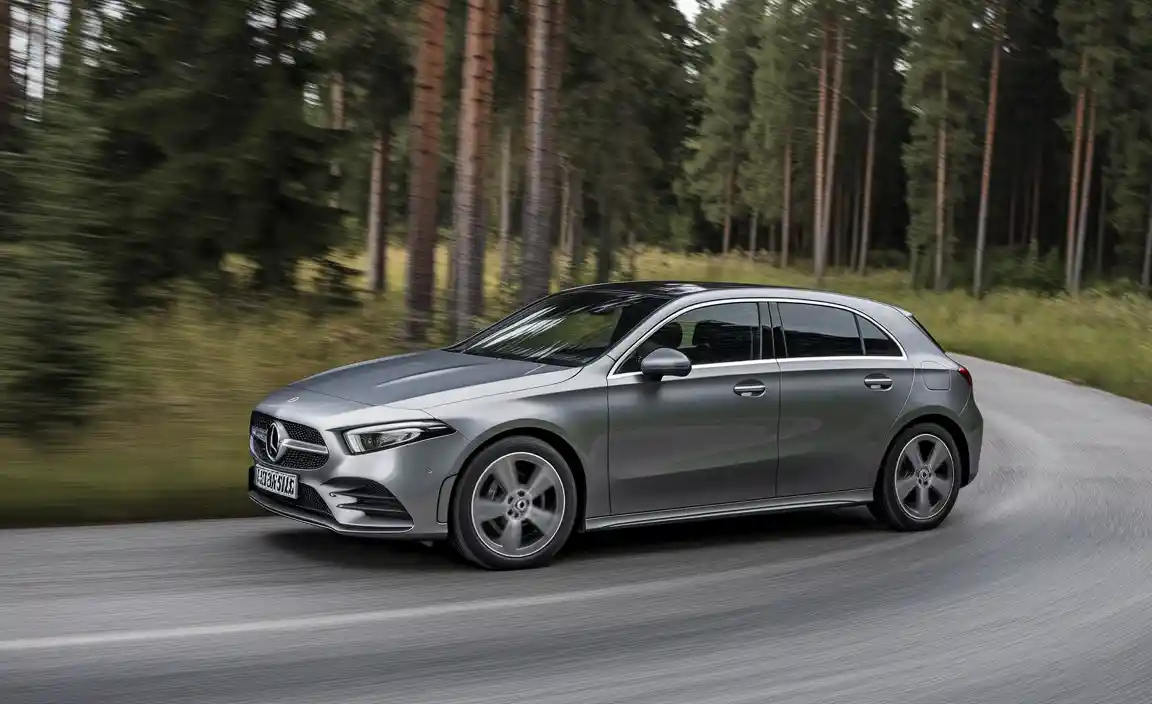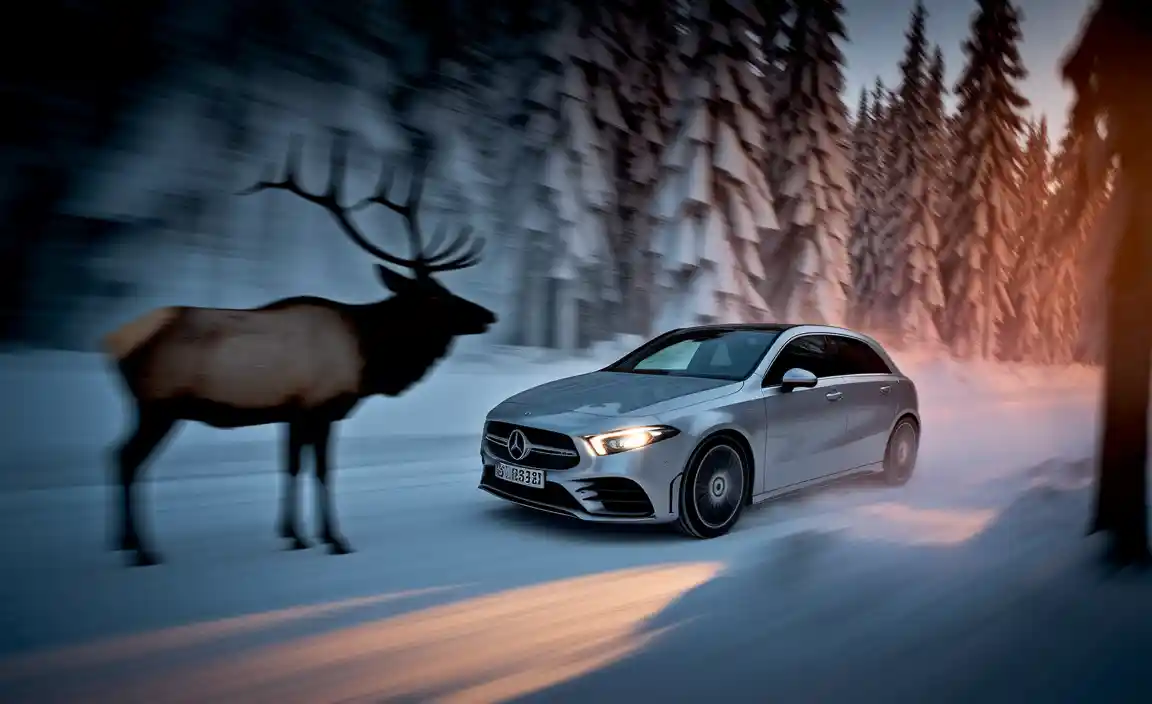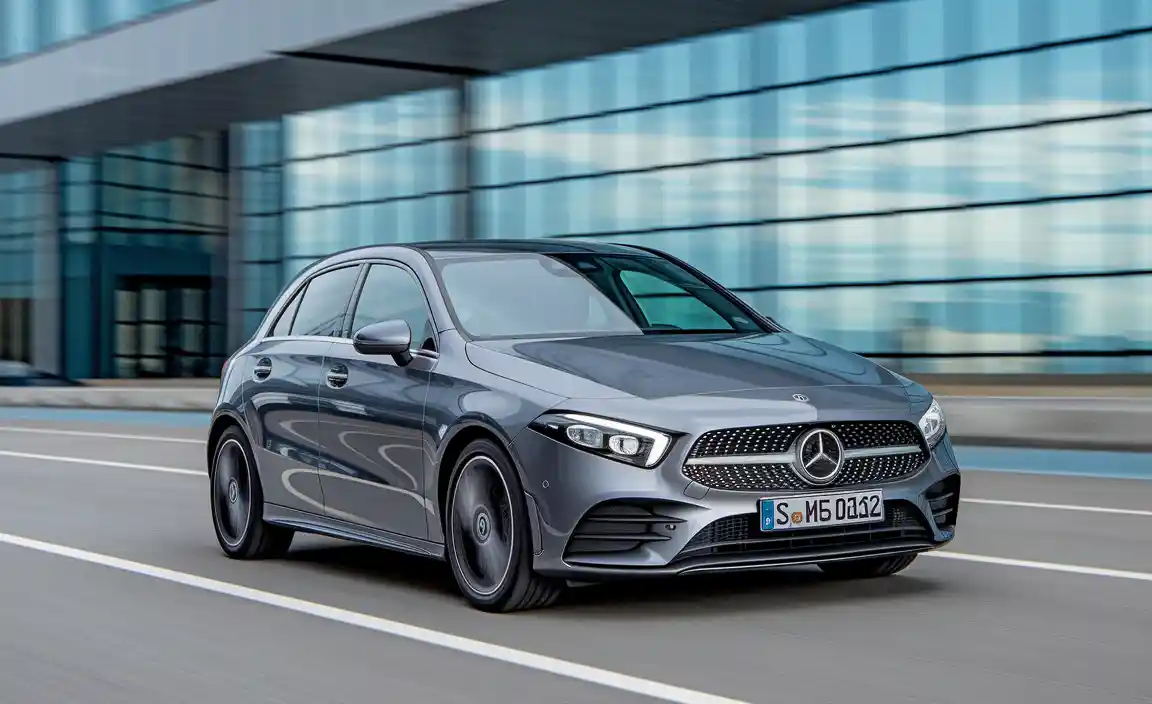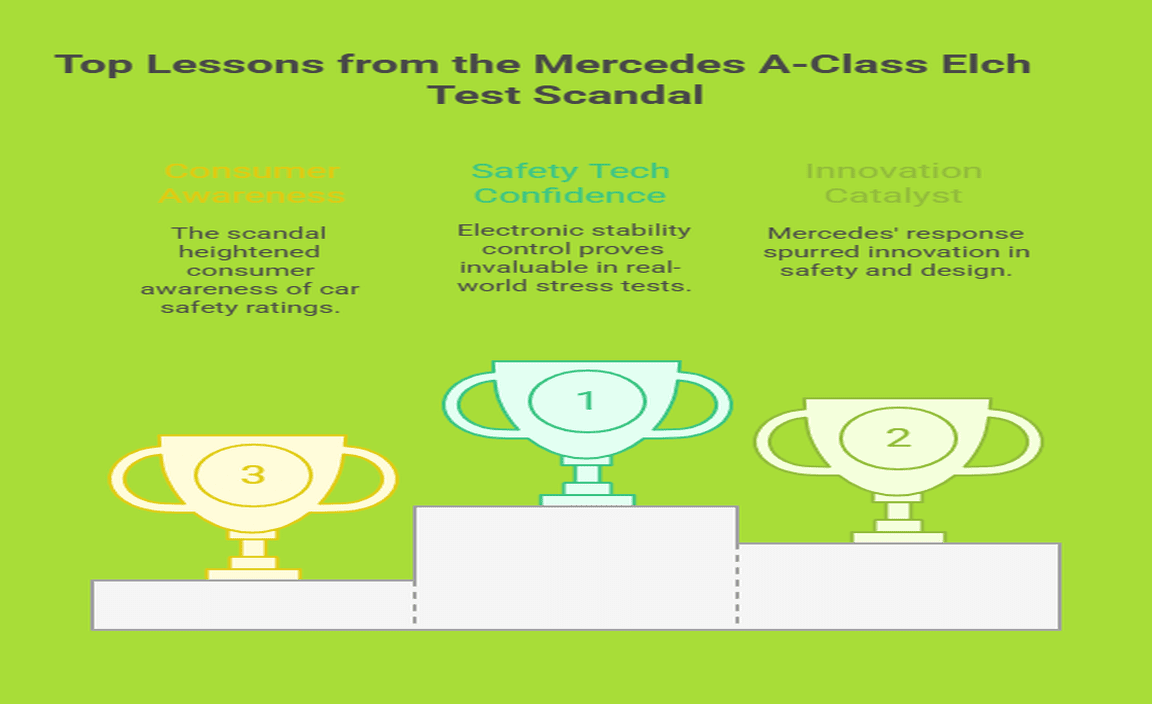You wouldn’t expect a luxury badge like Mercedes to end up on its side in the middle of a quiet Swedish road—but that’s exactly what happened. Back in 1997, during a routine moose avoidance test—also called the elch test—the brand-new Mercedes A-Class shocked the world by flipping over. What was supposed to be a triumph for Mercedes’ small car strategy became a global headline and an industry shake-up.

What followed was more than just damage control. It was a deep dive into gravity, safety standards, and what happens when a company built on prestige has to answer to real-world physics. This wasn’t just about one car failing. It was about trust, innovation, and a wake-up call that echoed far beyond Sweden.
Let’s revisit the twists, turns, and lessons of the Mercedes A-Class elch test scandal—and see how one unexpected incident changed the way we look at car safety forever.
Key Takeaways
- Moose/elch tests reveal corner-cases labs miss.
- Gravity is a silent but ruthless tester.
- Media pressure can drive swift change.
- Quick recalls and retrofits repair consumer trust.
- ESC became non-negotiable thanks to this test.
- The scandal pushed ALL cars toward better safety.
Mercedes And The Elch Test
I still remember when I first saw that moose-test video. The Mercedes A‑Class flipped like a toy—no joke. It happened during a “moose test” (elch test) in Sweden, and that single moment sparked what we now call the Mercedes A-Class elch test scandal. It shook the values of luxury and safety around cars forever.
The moose test—or elch test—is simple but brutal. Imagine someone—or a moose—darting into your lane at high speed. You swerve hard. Then you swerve back. The goal is to stay upright. The test blends speed, balance, and sharp steering. In Sweden, where elk literally storm roads, this became a cultural rite—and a safety must.

Purpose And Importance Of The Test
This isn’t a gimmick. It’s serious physics. It’s about gravity, inertia, and a car’s design working together to prevent disaster. Existing crash tests are about head-on collisions. The moose test adds a layer: surprise, real-world moves. It’s about whether a car can hold its ground, or topple over if pushed.
Commonly Evaluated Evasive Maneuvers
Drivers perform sharp S-curves at increasing speeds—usually starting at ~60 km/h. Cars are loaded to max to simulate real weight. Engineers observe steering, tire grip, suspension, and grip limits. They check at which speed the vehicle wobbles, skids, or flips—like it did with the original mercedes a class in 1997 .
The A‑Class Model
Features of the Original A‑Class
When Mercedes introduced the compact A‑Class, it was a bold step—a luxury car shrunk to urban size. The shape was tall, narrow, and modern. Its fuel efficiency and price tag attracted new buyers. Inside, it had a Mercedes feel—minus the bulk.
Mercedes had spent billions on this brand-new platform—about DM 2.5 billion. They positioned it as a “baby Merc”—a status symbol priced below C‑Class. Buyers expected it to be safe, reliable, and backed by Mercedes engineering.

The Incident: Details Of The Failed Test
On October 21, 1997, Teknikens Värld in Sweden ran the moose test. At around 60 km/h, the A‑Class flipped while executing the double lane-change maneuver. It wasn’t a small tip—it rolled fully, twice, frightening everyone inside.
That happened despite earlier internal tests showing only a slight wheel lift during sharp turns . It was proof that conventional protocols could miss intense real-world scenarios.
Initial Reactions And Media Coverage
Headlines exploded. European customers canceled roughly 4,000 orders after the flip. Publications like Süddeutsche Zeitung and the Washington Post highlighted the startling visuals and safety fears.
Mercedes initially denied fault—at first calling it manipulated. But the pressure mounted . It was a mercedes a-class elch test scandal—safe- image torn down in front of the world.
Impact On Mercedes‑Benz: Brand Reputation Challenges
Mercedes had always been about premium quality. The A‑Class flip challenged that. Sales ground to a halt. Daimler-Benz pulled production from 800 to 200 cars per day and suspended deliveries, recalling over 2,600 cars.
Brands like BMW, Audi, and Volvo watched closely. Social media buzzed: “If a Merc can flip, what about my car?”

Consumer Confidence Issues
Buyers hesitated. Could the A‑Class topple in real life? Tire pressure, center-of- gravity tweaks, ESC—none convinced consumers overnight. Forums and news were saturated with “gravity fails” talk. Mercedes’ sales projections sank in Europe.
Immediate Actions Taken: Mercedes’ Response Strategies
Mercedes didn’t sit idle. They recalled every sold A‑Class and offered free retrofits—like added Electronic Stability Control (ESP) and suspension tweaks—to about 18,000 units by February 1998.
The company plowed DM 300 million (about $173 million) into re-engineering. They widened the stance, altered the chassis, and added ESP—which had been optional only on S-Class.
They invited Swedish journalist Robert Collin and others for a redemption test in Spain and France. Even Nikki Lauda was brought in to validate controls.
By December, ads ran across 180 newspapers and German TV channels saying: “We made an error, but we have learned”.
Long-Term Design And Safety Modifications
Turning a failure into a lesson, Mercedes re-engineered the platform. They stiffened the frame, redistributed mass to lower the center-of- gravity, and standardized ESP across all models by 1999.
That investment—DM 300 million—was matched with another DM 2.5 billion spent developing the platform. They prioritized safety over margins, recalibrating any systems that could affect swerve stability.

Introduction Of Electronic Stability Control
ESP (Electronic Stability Program) became the hero. It uses wheel-speed, steering angle, and yaw sensors to detect and correct skids.
ESC wasn’t just a Band-Aid—it’s now considered one of the most significant safety advances of the late 20th century. It’s estimated to prevent a third of fatal crashes, and reduce rollover risk by up to 80% .
By making ESP standard across all passenger cars—and mandatory in Europe in 2011—Mercedes led a safety revolution.
Industry Repercussions
Changes In Safety Testing Standards
After the scandal, moose/elch tests found their place in mainstream evaluations. ISO 3888-2 adopted lane-change tests similar to elch tests. Magazines like Teknikens Värld kept testing cars yearly.
Consumers now raise eyebrows if a car doesn’t pass evasive maneuver tests. Ads began highlighting moose-test results—driven by safety-conscious attitudes and money spent.
Influence On Competitor Practices
Packaged ESC and moose testing became table stakes. BMW, Volkswagen, Toyota—all added moose-test testing and ESC standardization. Even GM and Ford began citing ESC in ads. The message? Don’t skip real-world safety.
Lessons Learned
Importance Of Rigorous Vehicle Testing
This saga proved lab testing isn’t enough. Real-world scenarios—sudden moves, weight shift, gravity focus—reveal gaps. The A‑Class flip was a loud reminder to include worst-case-manuever tests.
The Role Of Media In Automotive Safety
The story became bigger because of the media. The video went viral in ’97. Mercedes couldn’t ignore it. It forced transparency, fast action, and accountability. Today, you can’t hide a moose flip in the internet age.
Comparative Analysis
Similarities To Other Automotive Scandals
The A‑Class flip echoes crises like Toyota’s acceleration defect or GM’s ignition switch issues. In every case, the car’s reputation tied to the brand’s core values—safety and innovation.
Distinctive Features Of The A‑Class Case
This scandal stood out because it involved gravity and physics in plain sight. A luxury hatchback flipping for a moose was absurd and compelling. It was a visceral wake-up for consumers and execs alike.
My Personal Take
The mercedes a-class elch test scandal remains a pivotal moment. It taught that even premium cars must endure real-world stress. It showed how money invested in safety tech like electronic stability control pays back in confidence.
For Mercedes, it was a hard blow—but it spurred innovation. They embraced moose-test prep, EPS, and robust design. Customers gained safer cars. The whole industry leveled up.
I watched that Swedish video as a petrolhead teen. It shook me. I saw that physics wins over brand if you don’t plan ahead. Years later, when I bought my own compact ride, I checked stability ratings hard. That flip shaped how I judge cars.

Final Thoughts
That single flip in Sweden changed safety tech forever. It’s a reminder that even the finest brands must live up to their image. Customers trust makers with their lives and their money. The Mercedes A-Class story shows why trust must be earned—and why honesty and action matter when things go wrong.
Next time a car dodges a moose in a video, remember: behind that test is physics, design, money, and accountability. And lurking in every curve is gravity, waiting for the unprepared.
FAQs
- Mercedes A‑Class Involved In The Elch Test Scandal?
Mercedes A‑Class was involved in the Elch Test scandal when a first‑generation W168 flipped during a Swedish magazine’s evasive‑maneuver trial at about 65 km/h, triggering recalls and a production halt. - Mercedes A‑Class Flipped During Elch Test?
Mercedes A‑Class did flip during the Elch Test—when swerving at speed around cones, it completely rolled over, embarrassing the brand and making headlines across Europe. - Mercedes Recalled Cars After Elch Test Failure?
Mercedes recalled all approximately 2,600 A‑Class units sold at the time and suspended production for three months to retrofit Electronic Stability Program (ESP) and re‑tune the suspension - Mercedes Introduced ESP After Elch Test?
Mercedes introduced ESP across the A‑Class range after the Elch Test crisis, partnering with Bosch and making ESP standard on all W168 models to prevent future rollovers. - Mercedes Cost To Fix Elch Issue?
Mercedes spent roughly DM 2.5 billion developing the A‑Class and an additional DM 300 million to correct the Elch Test issues through recalls and upgrades. - Mercedes Stopped Production After Elch Test?
Mercedes stopped production of the A‑Class for three months following the Elch Test scandal, ensuring no unsafe cars reached consumers while fixes were implemented. - Mercedes Leadership Response To Elch Scandal?
Mercedes leadership responded to the Elch scandal with immediate transparency—issuing mass recalls, pausing production, and deploying a crisis response team led by then-CEO Juergen Hubbert. - Mercedes Made Changes To Suspension After Elch Test?
Mercedes strengthened the A‑Class suspension and upgraded tire specifications along with standard ESP installation to correct stability issues highlighted by the Elch Test. - Mercedes A‑Class Sales After The Scandal?
Mercedes A‑Class sales rebounded strongly after the scandal; over 1.1 million units were sold between 1997 and 2004, proving consumer trust returned once fixes were in place. - Mercedes Legacy Of The Elch Test Incident?
Mercedes’ legacy from the Elch Test incident includes pioneering safety: ESP became standard across compact models and influenced EU-wide stability regulations for new vehicles.